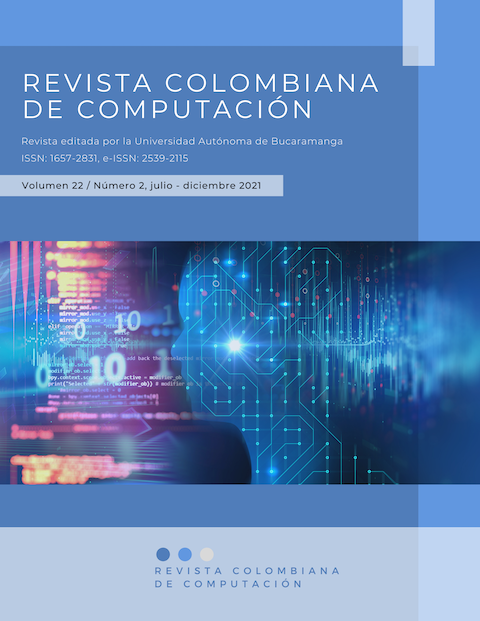Red neuronal artificial para la extracción de parámetros dinámicos de robots a partir de información incompleta de su movimiento
Resumen
Las redes neuronales artificiales son útiles para procesar datos con información incompleta para obtener una salida deseada. En los sistemas de medición de robots manipuladores, solo se toman muestras cuantificadas de la posición y, por lo tanto, no se puede ejecutar en un tiempo razonable algoritmos deterministas para extraer los parámetros del robot. En el estado del arte, se abordan algoritmos de extracción de parámetros basados en la suposición de que no existe la cuantificación de las señales del movimiento del robot y que la primera y segunda derivada de la posición son muestreadas y no estimadas. En este trabajo, se propone un algoritmo basado en una red neuronal entrenada para extraer los parámetros de un determinado robot para reducir el tiempo de caracterización del robot, además, con la metodología propuesta se pueden extraer parámetros dinámicos del mismo tipo de robot con el que se ha entrenado la red neuronal.
Referencias bibliográficas
Berzal, F. (2018). Redes Neuronales y Deep Learning. Ikor.
Chávez-Olivares, C., Reyes-Cortés, F., González-Galván, E., Mendoza-Gutierrez, M., & Bonilla-Gutierrez, I. (2012). Experimental Evaluation of Parameter Identification Schemes on an Anthropomorphic Direct Drive Robot. International Journal of Advanced Robotic Systems, 9(5). https://doi.org/10.5772/52190
Devore, J. L. (2011). Probability and Statistics for Engineering and the Sciences. Cengage learning.
Ding, Y., Zhao, B. Y., & Wu, B. (2014). Structural System Identification with Extended Kalman Filter and Orthogonal Decomposition of Excitation. Mathematical Problems in Engineering, 2014. https://doi.org/10.1155/2014/987694
Hu, J., & Xiong, R. (2018). Contact Force Estimation for Robot Manipulator Using Semiparametric Model and Disturbance Kalman Filter. IEEE Transactions on Industrial Electronics, 65(4). https://doi.org/10.1109/TIE.2017.2748056
Huynh, H. N., Assadi, H., Rivière-Lorphèvre, E., Verlinden, O., & Ahmadi, K. (2020). Modelling the dynamics of industrial robots for milling operations. Robotics and Computer-Integrated Manufacturing, 61. https://doi.org/10.1016/j.rcim.2019.101852
Kalman, R. E. (1960). A New Approach to Linear Filtering and Prediction Problems. Journal of Basic Engineering, 82(1). https://doi.org/10.1115/1.3662552
Lin, F.-J., Teng, L.-T., Chen, C.-Y., & Chang, C.-K. (2008). Robust RBFN Control for Linear InductionMotor Drive Using FPGA. IEEE Transactions on Power Electronics, 23(4). https://doi.org/10.1109/TPEL.2008.924604
Liu, N., Li, L., Hao, B., Yang, L., Hu, T., Xue, T., Wang, S., & Shao, X. (2020). Semiparametric Deep Learning Manipulator Inverse Dynamics Modeling Method for Smart City and Industrial Applications. Complexity, 2020. https://doi.org/10.1155/2020/9053715
Ogata, K. (1996). Sistemas de control en tiempo discreto. Pearson educacion.
Pohlman, J. T., & Leitner, D. W. (2003). A Comparison of Ordinary Least Squares and Logistic Regression. The Ohio Journal of Science, 103(5), 118–125.
Qin, Z., Baron, L., & Birglen, L. (2010). A new approach to the dynamic parameter identification of robotic manipulators. Robotica, 28(4). https://doi.org/10.1017/S0263574709990233
Soh, J., & Wu, X. (2017). An FPGA-Based Unscented Kalman Filter for System-On-Chip Applications. IEEE Transactions on Circuits and Systems II: Express Briefs, 64(4). https://doi.org/10.1109/TCSII.2016.2565730
Su, H., Qi, W., Yang, C., Sandoval, J., Ferrigno, G., & Momi, E. de. (2020). Deep Neural Network Approach in Robot Tool Dynamics Identification for Bilateral Teleoperation. IEEE Robotics and Automation Letters, 5(2). https://doi.org/10.1109/LRA.2020.2974445
Swevers, J., Ganseman, C., Tukel, D. B., de Schutter, J., & van Brussel, H. (1997). Optimal robot excitation and identification. IEEE Transactions on Robotics and Automation, 13(5). https://doi.org/10.1109/70.631234
Swevers, J., Verdonck, W., & de Schutter, J. (2007). Dynamic Model Identification for Industrial Robots. IEEE Control Systems, 27(5). https://doi.org/10.1109/MCS.2007.904659
Taylor, J. R. (2013). Mecánica clásica. Reverté.
Wang, S., Shao, X., Yang, L., & Liu, N. (2020). Deep Learning Aided Dynamic Parameter Identification of 6-DOF Robot Manipulators. IEEE Access, 8. https://doi.org/10.1109/ACCESS.2020.3012196
Wu, R.-T., & Jahanshahi, M. R. (2019). Deep Convolutional Neural Network for Structural Dynamic Response Estimation and System Identification. Journal of Engineering Mechanics, 145(1). https://doi.org/10.1061/(ASCE)EM.1943-7889.0001556
Xiao, W., Dunford, W. G., Palmer, P. R., & Capel, A. (2007). Application of Centered Differentiation and Steepest Descent to Maximum Power Point Tracking. IEEE Transactions on Industrial Electronics, 54(5). https://doi.org/10.1109/TIE.2007.899922
You, B., Qiao, M., Xu, J., & Liu, D. (2012). Low-Speed Control of Heavy-Load Transfer Robot with Long Telescopic Boom Based on Stribeck Friction Model. Mathematical Problems in Engineering, 2012. https://doi.org/10.1155/2012/432129













